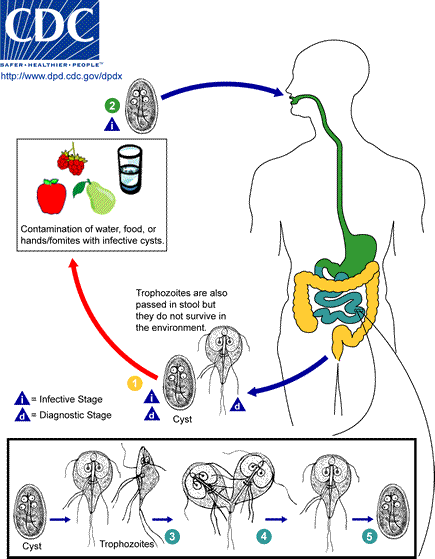|
Giardiasis
Giardiasis is a parasitic disease caused by the protist enteropathogen ''Giardia duodenalis'' (also known as ''G. lamblia'' and ''G. intestinalis''), especially common in children and travellers. Infected individuals experience steatorrhea, a type diarrhea with fatty sticky stool; abdominal pain, weight loss, and weakness due to dehydration and malabsorption. Less common symptoms include skin rash, hives and joint swelling. Symptoms usually begin one to three weeks after exposure and, without treatment, may last two to six weeks or longer. Some infected individuals experience mild or no symptoms and remain infection carries for a long time. Giardiasis spreads via feca-oral route, when ''Giardia'' cysts excreted with faeces contaminate food or water that is later consumed orally. The disease can also spread between people and between people and animals, mainly via pets. Cysts may survive for nearly three months in cold water. The microscopic identification of ''Giardia'' an ... [...More Info...] [...Related Items...] OR: [Wikipedia] [Google] [Baidu] |
Giardia Duodenalis
''Giardia duodenalis'', also known as ''Giardia intestinalis'' and ''Giardia lamblia'', is a flagellated Parasitism, parasitic protozoan microorganism of the genus ''Giardia'' that colonizes the small intestine, causing a diarrheal condition known as giardiasis. The parasite attaches to the intestinal epithelium by a ventral disc (''syn''. sucker (zoology), adhesive disc or sucker), and reproduction, reproduces via Fission (biology)#Binary_fission, binary fission. ''G. duodenalis'' is a non-invasive parasite, that does not spread to other parts of the gastrointestinal tract, but remains confined to the lumen (anatomy), lumen of the small intestine. The parasite exists in two forms; Trophozoite, trophozoites and Microbial cyst, cysts. The microorganism can undergo encystation, transforming into a dormant Microbial cyst, cyst that enables it to survive outside of its Host (biology), host. ''Giardia'' trophozoites are Anaerobic organism, anaerobic, and absorb their nutrients from th ... [...More Info...] [...Related Items...] OR: [Wikipedia] [Google] [Baidu] |
Metronidazole
Metronidazole, sold under the brand name Flagyl and Metrogyl among others, is an antibiotic and antiprotozoal medication. It is used either alone or with other antibiotics to treat pelvic inflammatory disease, endocarditis, and bacterial vaginosis. It is effective for dracunculiasis, giardiasis, trichomoniasis, and amebiasis. It is an option for a first episode of mild-to-moderate Clostridioides difficile infection, ''Clostridioides difficile'' colitis if vancomycin or fidaxomicin is unavailable. Metronidazole is available oral administration, orally (by mouth), as a cream or gel, and by slow intravenous infusion (injection into a vein). Common side effects include nausea, Dysgeusia, a metallic taste, Anorexia (symptom), loss of appetite, and headaches. Occasionally seizures or allergies to the medication may occur. Some state that metronidazole should not be used in early pregnancy, while others state doses for trichomoniasis are safe. Metronidazole is generally considered com ... [...More Info...] [...Related Items...] OR: [Wikipedia] [Google] [Baidu] |
Mepacrine
Mepacrine, also called quinacrine or by the trade names Atabrine or Atebrin, is a medication with several uses. It is related to chloroquine and mefloquine. Although available from compounding pharmacies, as of August 2020 approved formulations are not available in the United States. Medical uses The main uses of mepacrine are as an antiprotozoal, antirheumatic, and an intrapleural sclerosing agent. Possible reasons for the lack of an ''in vivo effect'' include inefficient penetration of the blood–brain barrier, as well as the existence of drug-resistant prion proteins that increase in number when selected for by treatment with mepacrine. Non-surgical sterilization for women The use of mepacrine for non-surgical Sterilization (medicine), sterilization for women has also been studied. The first report of this method claimed a first year failure rate of 3.1%. However, despite a multitude of clinical studies on the use of mepacrine and female sterilization, no randomized, contr ... [...More Info...] [...Related Items...] OR: [Wikipedia] [Google] [Baidu] |
Albendazole
Albendazole is a broad-spectrum antihelmintic and antiprotozoal agent of the benzimidazole type. It is used for the treatment of a variety of intestinal parasite infections, including ascariasis, pinworm infection, hookworm infection, trichuriasis, strongyloidiasis, taeniasis, clonorchiasis, opisthorchiasis, cutaneous larva migrans, giardiasis, and gnathostomiasis, among other diseases. Common side effects include nausea, abdominal pain, and headache. Rare but potentially serious side effects include bone marrow suppression which usually improves on discontinuing the medication. Hepatitis, Liver inflammation has been reported and those with prior liver problems are at greater risk. It is pregnancy category D in Australia, meaning it may cause harm if taken by pregnant women. Albendazole was developed in 1975. It is on the WHO Model List of Essential Medicines, World Health Organization's List of Essential Medicines. Albendazole is available in a fixed-dose combination with ... [...More Info...] [...Related Items...] OR: [Wikipedia] [Google] [Baidu] |
Parasitic Disease
A parasitic disease, also known as parasitosis, is an infectious disease caused by parasites. Parasites are organisms which derive sustenance from its host while causing it harm. The study of parasites and parasitic diseases is known as parasitology. Medical parasitology is concerned with three major groups of parasites: parasitic protozoa, helminths, and parasitic arthropods. Parasitic diseases are thus considered those diseases that are caused by pathogens belonging taxonomically to either the animal kingdom, or the protozoan kingdom. Terminology Although organisms such as bacteria function as parasites, the usage of the term "parasitic disease" is usually more restricted. The three main types of organisms causing these conditions are protozoa (causing protozoan infection), helminths ( helminthiasis), and ectoparasites. Protozoa and helminths are usually endoparasites (usually living inside the body of the host), while ectoparasites usually live on the surface of the h ... [...More Info...] [...Related Items...] OR: [Wikipedia] [Google] [Baidu] |
Scanning Electron Microscope
A scanning electron microscope (SEM) is a type of electron microscope that produces images of a sample by scanning the surface with a focused beam of electrons. The electrons interact with atoms in the sample, producing various signals that contain information about the surface topography and composition. The electron beam is scanned in a raster scan pattern, and the position of the beam is combined with the intensity of the detected signal to produce an image. In the most common SEM mode, secondary electrons emitted by atoms excited by the electron beam are detected using a secondary electron detector ( Everhart–Thornley detector). The number of secondary electrons that can be detected, and thus the signal intensity, depends, among other things, on specimen topography. Some SEMs can achieve resolutions better than 1 nanometer. Specimens are observed in high vacuum in a conventional SEM, or in low vacuum or wet conditions in a variable pressure or environmental SEM, an ... [...More Info...] [...Related Items...] OR: [Wikipedia] [Google] [Baidu] |
Joint Effusion
A joint effusion is the presence of increased intra-articular fluid. It may affect any joint. Commonly it involves the knee (see knee effusion). Diagnostic approach The approach to diagnosis depends on the joint involved. While aspiration of the joint is considered the gold standard of treatment, this can be difficult for joints such as the hip. Ultrasound may be used both to verify the existence of an effusion and to guide aspiration. File:Knee effusion.jpg, Skyline view of the patella demonstrating a large joint effusion as marked by the arrow. File:Sail sign.jpg, A schematic drawing showing the sail sign which represents an effusion. Differential diagnosis There are many causes of joint effusion. It may result from trauma, inflammation, hematologic conditions, or infections. Septic arthritis Septic arthritis is the purulent invasion of a joint by an infectious agent with a resultant large effusion due to inflammation. Septic arthritis is a serious condition. I ... [...More Info...] [...Related Items...] OR: [Wikipedia] [Google] [Baidu] |
Fecal–oral Route
The fecal–oral route (also called the oral–fecal route or orofecal route) describes a particular route of transmission of a disease wherein pathogens in fecal particles pass from one person to the mouth of another person. Main causes of fecal–oral disease transmission include lack of adequate sanitation (leading to open defecation), and poor hygiene practices. If soil or water bodies are polluted with fecal material, humans can be infected with waterborne diseases or soil-transmitted diseases. Fecal contamination of food is another form of fecal-oral transmission. Washing hands properly after changing a baby's diaper or after performing anal hygiene can prevent foodborne illness from spreading..Toilet flushing & subsequent inhaled aerosols is another potential route. The common factors in the fecal-oral route can be summarized as five Fs: fingers, flies, fields, fluids, and food. Diseases caused by fecal-oral transmission include typhoid, cholera, polio, hepat ... [...More Info...] [...Related Items...] OR: [Wikipedia] [Google] [Baidu] |
ELISA
The enzyme-linked immunosorbent assay (ELISA) (, ) is a commonly used analytical biochemistry assay, first described by Eva Engvall and Peter Perlmann in 1971. The assay is a solid-phase type of enzyme immunoassay (EIA) to detect the presence of a ligand (commonly an amino acid) in a liquid sample using antibodies directed against the ligand to be measured. ELISA has been used as a medical diagnosis, diagnostic tool in medicine, plant pathology, and biotechnology, as well as a quality control check in various industries. In the most simple form of an ELISA, antigens from the sample to be tested are attached to a surface. Then, a matching antibody is applied over the surface so it can bind the antigen. This antibody is linked to an enzyme, and then any unbound antibodies are removed. In the final step, a substance containing the enzyme's Enzyme substrate, substrate is added. If there was binding, the subsequent reaction produces a detectable signal, most commonly a color change. ... [...More Info...] [...Related Items...] OR: [Wikipedia] [Google] [Baidu] |
Tinidazole
Tinidazole, sold under the brand name Tindamax among others, is a medication used against protozoan infections. It is widely known throughout Europe and the developing world as a treatment for a variety of anaerobic amoebic and bacterial infections. It was developed in 1972 and is a prominent member of the nitroimidazole antibiotic class. It is on the World Health Organization's List of Essential Medicines. Medical uses Tinidazole may be a therapeutic alternative in the setting of metronidazole intolerance. Tinidazole is used to treat ''Helicobacter pylori'', Amoebic dysentery, ''Giardia'' and ''Trichomonas vaginalis''. Side effects Drinking alcohol while taking tinidazole causes an unpleasant disulfiram-like reaction, which includes nausea, vomiting, headache, increased blood pressure, flushing, and shortness of breath. Pharmacology Pharmacokinetics Elimination half-life is 13.2 ± 1.4 hours. Plasma half-life is 12 to 14 hours. History Tinidazole was approved for treatm ... [...More Info...] [...Related Items...] OR: [Wikipedia] [Google] [Baidu] |
PCR Amplification
The polymerase chain reaction (PCR) is a method widely used to make millions to billions of copies of a specific DNA sample rapidly, allowing scientists to amplify a very small sample of DNA (or a part of it) sufficiently to enable detailed study. PCR was invented in 1983 by American biochemist Kary Mullis at Cetus Corporation. Mullis and biochemist Michael Smith, who had developed other essential ways of manipulating DNA, were jointly awarded the Nobel Prize in Chemistry in 1993. PCR is fundamental to many of the procedures used in genetic testing and research, including analysis of ancient samples of DNA and identification of infectious agents. Using PCR, copies of very small amounts of DNA sequences are exponentially amplified in a series of cycles of temperature changes. PCR is now a common and often indispensable technique used in medical laboratory research for a broad variety of applications including biomedical research and forensic science. The majority of PCR met ... [...More Info...] [...Related Items...] OR: [Wikipedia] [Google] [Baidu] |
Hygiene
Hygiene is a set of practices performed to preserve health. According to the World Health Organization (WHO), "Hygiene refers to conditions and practices that help to maintain health and prevent the spread of diseases." Personal hygiene refers to maintaining the body's cleanliness. Hygiene activities can be grouped into the following: home and everyday hygiene, personal hygiene, medical hygiene, sleep hygiene, and Food safety, food hygiene. Home and every day hygiene includes hand washing, respiratory hygiene, food hygiene at home, hygiene in the kitchen, hygiene in the bathroom, laundry hygiene, and medical hygiene at home. And also environmental hygiene in the society to prevent all kinds of bacterias from penetrating into our homes. Many people equate hygiene with "cleanliness", but hygiene is a broad term. It includes such personal habit choices as how frequently to take a shower or bath, wash hands, trim Nail (anatomy), fingernails, and wash clothes. It also includes atte ... [...More Info...] [...Related Items...] OR: [Wikipedia] [Google] [Baidu] |







